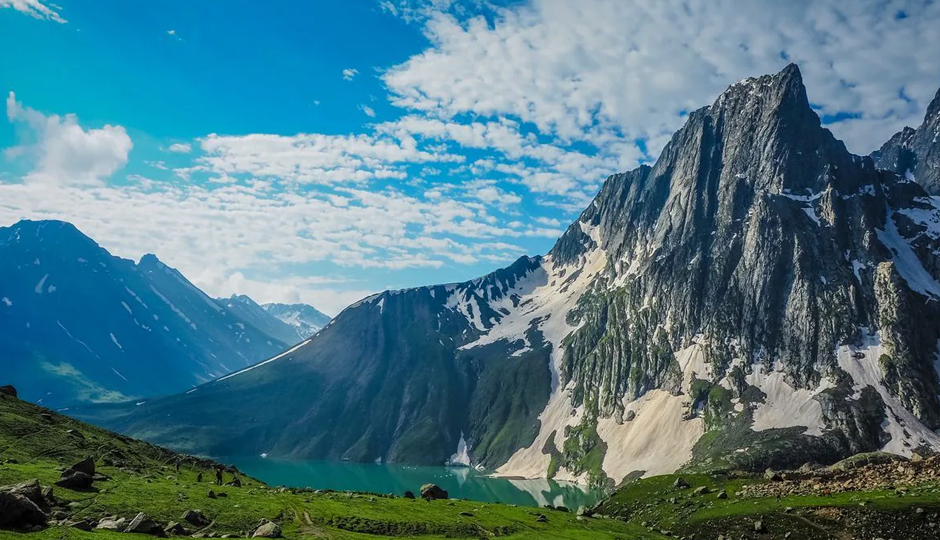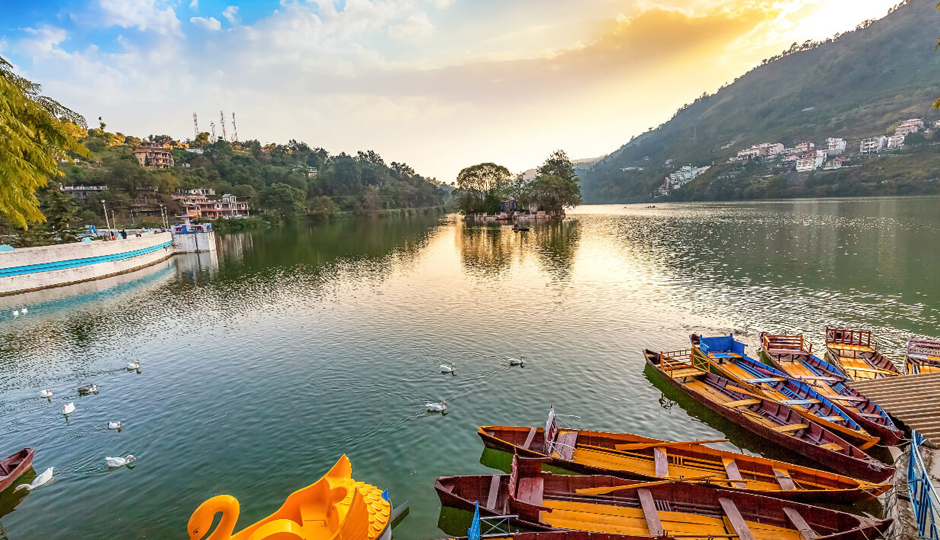9 UNESCO World Heritage Sites You Can Visit In India
By: Priyanka Maheshwari Thu, 08 June 2023 4:13:13
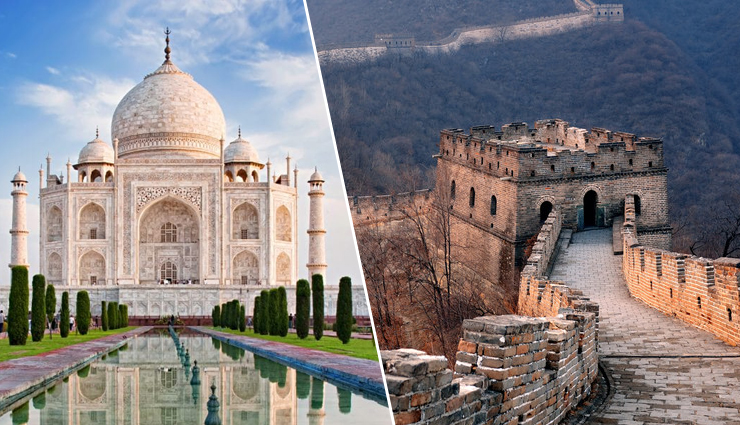
India is a country with a rich and diverse cultural heritage that spans thousands of years. It is home to numerous magnificent historical monuments, architectural wonders, natural landscapes, and cultural sites. Recognizing the outstanding universal value of these exceptional sites, many of them have been designated as UNESCO World Heritage Sites.
UNESCO, the United Nations Educational, Scientific and Cultural Organization, identifies and protects places of outstanding cultural or natural importance. These sites are considered to be of immense value to humanity and are carefully preserved for future generations.
India boasts an impressive total of 38 UNESCO World Heritage Sites, making it one of the countries with the highest number of such sites in the world. These sites are spread across the length and breadth of the country, showcasing India's rich history, cultural diversity, and natural beauty.
The World Heritage Sites in India encompass a wide range of treasures, including ancient cave complexes, architectural marvels, grand forts, serene temples, stunning mountain ranges, lush national parks, and breathtaking natural landscapes. Each site offers a unique glimpse into India's past, its artistic achievements, and its deep spiritual and cultural roots.
Some of the most renowned UNESCO World Heritage Sites in India include the magnificent Taj Mahal in Agra, a symbol of eternal love and one of the New Seven Wonders of the World. The majestic Qutub Minar and Red Fort in Delhi, which are splendid examples of Indo-Islamic architecture. The awe-inspiring group of monuments at Hampi, showcasing the ruins of the once-glorious Vijayanagara Empire. The stunning landscapes of the Western Ghats, which are home to several biodiversity hotspots. The architectural wonders of Ellora and Ajanta Caves, known for their intricate rock-cut sculptures and ancient Buddhist art. The breathtaking hill forts of Rajasthan, such as Chittorgarh, Kumbhalgarh, and Ranthambore, which reflect the grandeur of Rajputana architecture. And the sacred city of Varanasi, a spiritual and cultural hub that has attracted pilgrims and travelers for centuries.
These UNESCO World Heritage Sites in India serve as windows into the country's past, providing invaluable insights into its rich cultural tapestry, architectural brilliance, and natural wonders. They not only inspire awe and admiration but also contribute to the promotion of tourism, cultural exchange, and the preservation of India's diverse heritage.
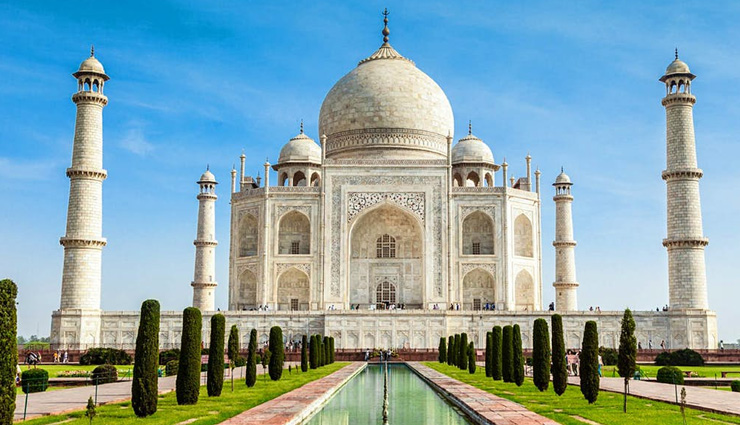
# Taj Mahal, Agra
The Taj Mahal, located in Agra, is one of the most iconic and renowned monuments in the world. It stands as a testament to love, beauty, and architectural brilliance. Built by the Mughal emperor Shah Jahan in the 17th century, the Taj Mahal is considered a masterpiece of Mughal architecture.
Situated on the banks of the Yamuna river, the Taj Mahal is a mausoleum constructed entirely of white marble. Its symmetrical design and intricate detailing make it a marvel to behold. The monument is especially captivating during sunrise and sunset when the changing light casts a mesmerizing glow upon its facade.
The Taj Mahal was built as a memorial to Shah Jahan's beloved wife, Mumtaz Mahal. The story goes that she held a special place in his heart, and upon her untimely death, he commissioned the construction of the Taj Mahal as her final resting place. The monument stands as a symbol of eternal love and has become an enduring symbol of India.
Visitors to the Taj Mahal can explore its stunning gardens, intricate calligraphy, and delicate marble inlays. The central dome, flanked by four minarets, is an iconic feature that adorns countless postcards and photographs. Inside the mausoleum, lies the tombs of Shah Jahan and Mumtaz Mahal, creating an atmosphere of serenity and reverence.
The Taj Mahal is not only a UNESCO World Heritage Site but also holds a special place in the hearts of millions of people around the world. Its architectural grandeur, artistic intricacy, and emotional significance make it a must-visit destination for travelers seeking to experience the rich history and cultural heritage of India.

# Hampi, Karnataka
Hampi, located in the state of Karnataka, India, is an extraordinary UNESCO World Heritage Site that captivates visitors with its ancient ruins, magnificent architecture, and breathtaking landscapes. It was once the capital of the Vijayanagara Empire, one of the most prosperous and powerful kingdoms in South India during the 14th to 16th centuries.
Set amidst a rocky terrain along the banks of the Tungabhadra River, Hampi is a treasure trove of historical and archaeological wonders. The ruins of this once-thriving city sprawl over a vast area, featuring grand temples, palaces, markets, and other structures that showcase the architectural brilliance of the Vijayanagara Empire.
One of the most iconic landmarks in Hampi is the Virupaksha Temple, dedicated to Lord Shiva. This ancient temple, with its towering gopuram (gateway tower) and intricate carvings, is still an active place of worship today. The Vittala Temple is another architectural marvel, known for its famous Stone Chariot and musical pillars that produce melodic sounds when tapped.
Exploring Hampi allows visitors to witness the remnants of a glorious past. The Royal Enclosure, the Zenana Enclosure (the women's quarters), and the Elephant Stables provide glimpses into the opulence and lifestyle of the Vijayanagara rulers. The Stepped Tank, a remarkable ancient water reservoir, and the Lotus Mahal, an elegant pavilion, are other notable attractions within the complex.
Beyond the architectural wonders, Hampi is blessed with natural beauty. The surrounding landscape is dotted with massive boulders, lush banana plantations, and rice fields, creating a picturesque backdrop for exploration and photography. The nearby Matanga Hill offers panoramic views of the entire Hampi area, especially stunning during sunrise and sunset.
Apart from its historical and natural attractions, Hampi also hosts vibrant festivals and cultural events that bring the ancient traditions and customs of the region to life. The Hampi Utsav, a grand celebration of music, dance, and art, attracts visitors from far and wide.
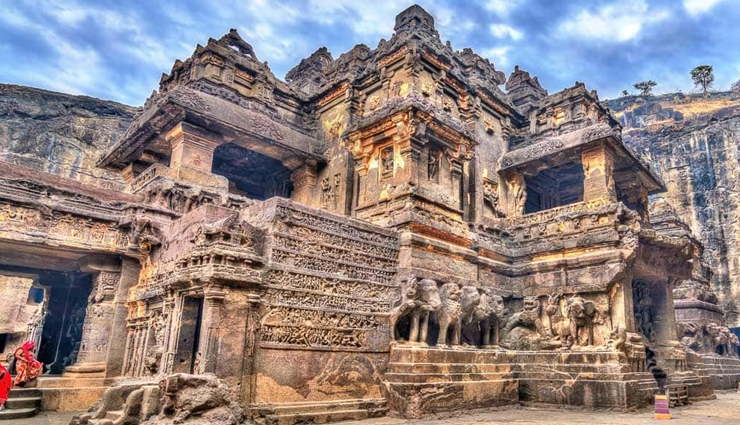
# Ajanta Caves, Aurangabad
Located near Aurangabad in Maharashtra, India, the Ajanta Caves is a remarkable UNESCO World Heritage Site that showcases ancient Buddhist rock-cut architecture and exquisite mural paintings. These caves are a testament to the artistic and cultural achievements of India's ancient past.
The Ajanta Caves date back to the 2nd century BCE and were rediscovered in the 19th century. Carved into a horseshoe-shaped cliff, the site consists of 30 Buddhist caves, including prayer halls, monasteries, and chaityas (worship halls). These caves served as secluded retreats for Buddhist monks, offering spaces for meditation, study, and religious ceremonies.
What sets the Ajanta Caves apart are their stunning frescoes and murals that adorn the walls and ceilings of the caves. These magnificent paintings depict various scenes from the life of the Buddha, Jataka tales (stories of the Buddha's previous lives), and other significant Buddhist narratives. The intricate detailing, vibrant colors, and skillful execution of these artworks make them an exceptional example of ancient Indian art.
The Ajanta Caves are not only known for their paintings but also for their rock-cut sculptures. Elaborate carvings of deities, bodhisattvas, and mythical creatures can be found throughout the caves, showcasing the mastery of the craftsmen of that era.
Visiting the Ajanta Caves is a journey into the past, allowing visitors to explore the rich artistic heritage of ancient India. The caves are organized in two groups, with Cave 1 being the most significant and Cave 26 housing the famous reclining Buddha statue. As you walk through the dimly lit interiors, the play of light and shadow enhances the mystical atmosphere of the caves.
It's worth noting that due to the delicate nature of the paintings, photography is prohibited inside the caves to preserve their integrity. However, there are replicas and replicas of some of the murals and sculptures on display in the nearby Ajanta Visitor Center, providing a glimpse into the intricate details and beauty of the original artworks.
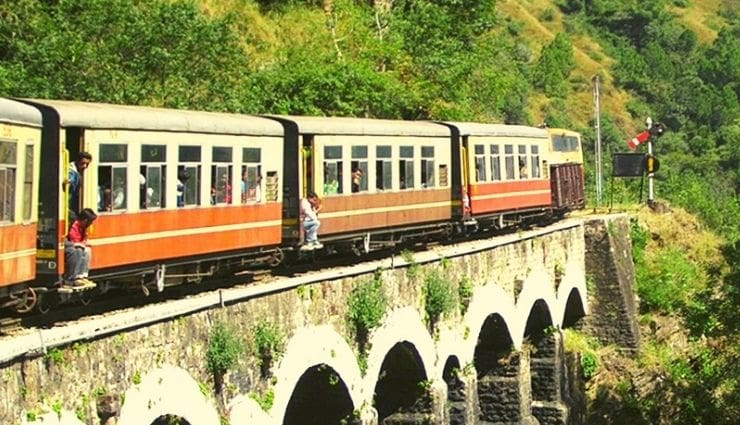
# Mountain Railway of India
The Mountain Railways of India refers to a collective UNESCO World Heritage Site consisting of three historic railway lines located in different regions of India. These railway lines are renowned for their engineering marvels and scenic beauty, offering an extraordinary journey through the picturesque landscapes of the Himalayas and the Nilgiri Hills.
- Darjeeling Himalayan Railway (DHR): Also known as the "Toy Train," the Darjeeling Himalayan Railway is located in the state of West Bengal. It was built in the late 19th century and covers a distance of 88 kilometers, connecting the town of New Jalpaiguri to Darjeeling. The narrow-gauge railway passes through tea gardens, forests, and quaint hillside villages, offering breathtaking views of the snow-capped peaks of the Eastern Himalayas.
- Nilgiri Mountain Railway (NMR): The Nilgiri Mountain Railway is situated in the southern state of Tamil Nadu. This rack and pinion railway was completed in 1908 and covers a distance of 46 kilometers from Mettupalayam to Ooty. The journey takes passengers through lush green forests, verdant tea estates, and scenic valleys, ascending to an altitude of around 2,200 meters. The NMR is famous for its unique X-shaped switchbacks and its iconic blue and cream-colored steam locomotives.
- Kalka-Shimla Railway: The Kalka-Shimla Railway is located in the northern state of Himachal Pradesh. It was constructed in the late 19th century and covers a distance of 96 kilometers from Kalka to Shimla. This narrow-gauge railway winds through the Shivalik mountain range, passing through 102 tunnels, and over 800 bridges. The journey offers mesmerizing views of the Himalayan foothills, lush forests, and charming hillside stations.
These mountain railways are not only important transportation links but also popular tourist attractions. They have retained their heritage charm, with vintage steam locomotives and old-world railway stations. The joy of traveling on these historic railways lies not only in reaching the destinations but also in the experience of the journey itself. The slow pace, the rhythmic chug of the train, and the stunning vistas make it a truly unforgettable adventure.
The Mountain Railways of India are not only a testament to the engineering prowess of the past but also a means to experience the natural beauty and cultural heritage of the regions they traverse. They continue to be cherished as iconic symbols of India's rich railway history and are beloved by both locals and tourists seeking a nostalgic and scenic escapade in the lap of mountains.

# Kaziranga National Park, Assam
Kaziranga National Park, situated in the state of Assam, India, is a UNESCO World Heritage Site and one of the most renowned wildlife reserves in the country. Spanning an area of approximately 430 square kilometers, the park is celebrated for its exceptional biodiversity and its role in the conservation of the endangered one-horned rhinoceros.
Kaziranga National Park is characterized by vast stretches of marshland, dense forests, and expansive grasslands. It is home to a remarkable variety of flora and fauna, making it a paradise for nature lovers and wildlife enthusiasts. The park is primarily known for its successful conservation efforts that have led to the preservation of the one-horned rhinoceros population, which is the largest in the world.
The one-horned rhinoceros, with its prehistoric appearance, is the flagship species of Kaziranga. Other significant animal species that inhabit the park include Asian elephants, wild water buffaloes, Bengal tigers, leopards, and various species of deer. The park is also a haven for birdwatchers, as it boasts an impressive array of resident and migratory bird species, including waterfowl, raptors, and numerous songbirds.
Visitors to Kaziranga National Park have the opportunity to explore the vast wilderness through jeep safaris and elephant-back rides. These excursions offer thrilling encounters with the park's wildlife and allow visitors to witness the incredible beauty of the natural surroundings. The park is divided into different zones to manage tourism activities effectively and minimize disturbance to the wildlife.
Apart from its rich wildlife, Kaziranga is renowned for its unique ecosystem and stunning landscapes. The park is intersected by the mighty Brahmaputra River, which adds to its scenic beauty. The wetlands, grasslands, and forests provide a diverse habitat for a wide range of plant species, including tall elephant grass, dense evergreen forests, and numerous wetland plants.
Kaziranga National Park also plays a crucial role in the conservation of other endangered species, such as the Bengal florican, the swamp deer, and the black-breasted parrotbill. Conservation efforts within the park focus not only on safeguarding the wildlife but also on promoting sustainable tourism and supporting the local communities residing in the region.

# Khajuraho, Madhya Pradesh
Khajuraho, located in the state of Madhya Pradesh, India, is a world-renowned UNESCO World Heritage Site known for its stunning group of temples. These temples are famous for their intricate and exquisite carvings, which depict a fascinating blend of art, architecture, and religious symbolism.
The temples of Khajuraho were built during the Chandela dynasty, between the 9th and 11th centuries. Originally, there were around 85 temples, but today, only about 20 temples remain. These temples are divided into three main groups: the Western Group, the Eastern Group, and the Southern Group.
The Western Group of temples in Khajuraho is the most famous and well-preserved. It consists of magnificent temples dedicated to both Hindu and Jain deities. The temples of this group are known for their elaborate sculptures and erotic carvings that depict various aspects of human life, sensuality, and spirituality. The most iconic temple in the Western Group is the Kandariya Mahadeva Temple, which features intricate detailing, tall spires, and a grand entrance.
The Eastern Group of temples, located near the Khajur Sagar Lake, includes the Jain temples. These temples exhibit a more serene and austere style compared to the Western Group. The Parsvanath Temple, Adinath Temple, and Ghantai Temple are among the notable structures in this group.
The Southern Group of temples is a bit more secluded and less visited but holds its own architectural charm. The Dulhadeo Temple and Chaturbhuj Temple are prominent examples of this group, showcasing unique architectural styles and intricate carvings.
The temples of Khajuraho are not only remarkable for their architectural brilliance but also for the themes depicted in their carvings. The sculptures beautifully portray various deities, celestial beings, mythical creatures, animals, and everyday life scenes. They are a testament to the rich cultural heritage and artistic achievements of ancient India.
Aside from the temples, Khajuraho also offers a glimpse into the local lifestyle and craftsmanship. The town itself has a relaxed and laid-back atmosphere, with colorful markets and handicraft shops selling local artwork, textiles, and souvenirs.
The annual Khajuraho Dance Festival, held against the backdrop of the temples, is a major cultural event that attracts artists and visitors from all over the world. The festival showcases traditional Indian classical dance forms, bringing the temples to life with mesmerizing performances.
A visit to Khajuraho allows travelers to immerse themselves in the splendor of ancient Indian art and architecture. It offers a unique opportunity to explore the intricate carvings, unravel the mysteries behind the symbolism, and appreciate the masterful craftsmanship that has withstood the test of time. Khajuraho is a true testament to the rich cultural heritage of India and a must-visit destination for history enthusiasts, art lovers, and those seeking a glimpse into the country's glorious past.
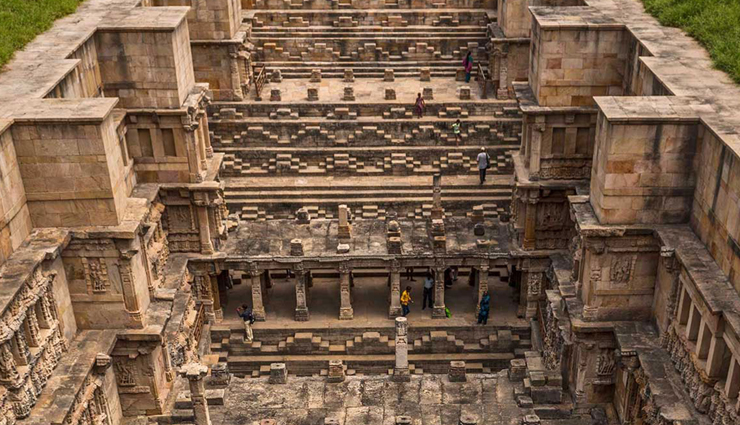
# Rani ki Vav, Patan, Gujarat
Rani ki Vav, located in the town of Patan in Gujarat, India, is a remarkable stepwell and UNESCO World Heritage Site. It stands as a testament to the architectural brilliance and artistic grandeur of ancient India.
Rani ki Vav, which translates to "Queen's Stepwell," was built in the 11th century by Queen Udayamati in memory of her husband, King Bhimdev I of the Solanki dynasty. The stepwell served as a multi-purpose structure, providing water storage, a place for social gatherings, and a spiritual retreat.
What sets Rani ki Vav apart is its intricate and ornate carvings, which adorn the walls, pillars, and even the steps of the stepwell. The carvings depict a wide range of subjects, including mythological scenes, religious motifs, deities, celestial beings, and everyday life scenes. The attention to detail and the precision of the carvings are awe-inspiring.
Descending into Rani ki Vav, visitors are greeted by a series of beautifully carved panels that showcase the cultural and artistic heritage of ancient India. The walls are adorned with intricate sculptures of deities like Vishnu, Shiva, and Brahma, as well as various celestial nymphs, musicians, and divine guardians. The lower levels of the stepwell feature a mesmerizing display of more than 800 sculptures, each telling a story and adding to the overall narrative of the site.
Rani ki Vav is not only a visual spectacle but also an architectural marvel. The stepwell is designed in the Maru-Gurjara architectural style, characterized by elaborate detailing and geometric patterns. The precise alignment of the steps, the symmetry of the structure, and the intricate network of columns and chambers showcase the engineering brilliance of the time.
The stepwell was buried under layers of silt and debris for centuries before its rediscovery and subsequent restoration in the 20th century. The restoration work has brought Rani ki Vav back to its former glory, allowing visitors to witness and appreciate its true splendor.

# Ahmedabad
Ahmedabad is a vibrant city located in the state of Gujarat, India. It is the largest city in Gujarat and serves as its commercial and cultural hub. With a rich history, thriving industries, and a blend of modern and traditional elements, Ahmedabad offers a diverse and dynamic experience for visitors.
Historically, Ahmedabad holds great significance as it was founded in the 15th century by Sultan Ahmed Shah. The city served as the capital of the Gujarat Sultanate and later became an important center of trade and commerce during the Mughal era. Its historical heritage is evident in its architectural treasures, including magnificent mosques, intricate stepwells, and grand palaces.
One of the most iconic landmarks in Ahmedabad is the Sabarmati Ashram, the former residence of Mahatma Gandhi, the Father of the Nation. The ashram is a place of pilgrimage for those interested in Gandhi's philosophy of nonviolence and his role in India's struggle for independence. Visitors can explore the ashram, learn about Gandhi's life and teachings, and witness the spinning wheel, an emblematic symbol of the Khadi movement.
Ahmedabad is also known for its vibrant and colorful festivals. The city comes alive during Navratri, a nine-night festival dedicated to the worship of the Hindu goddess Durga. It is celebrated with traditional dance forms like Garba and Dandiya-Raas, where people gather in large numbers to dance, sing, and revel in the festive spirit. The International Kite Festival, held on the occasion of Makar Sankranti, is another popular event where the sky is filled with colorful kites of all shapes and sizes.
The city's architecture is a unique blend of modern and traditional styles. The Bhadra Fort, built in the 15th century, stands as a symbol of the city's rich heritage. The Jumma Masjid, with its intricate lattice work and beautiful pillars, showcases the influence of Islamic architecture. The Adalaj Stepwell, located on the outskirts of Ahmedabad, is a stunning example of ancient stepwell architecture, adorned with intricate carvings and delicate motifs.
Ahmedabad is also known for its thriving textile industry and is often referred to as the "Manchester of the East." The city is famous for its handcrafted textiles, including the exquisite Patola silk sarees, Bandhani (tie-dye) fabrics, and block-printed textiles. Visitors can explore bustling textile markets like the famous Manek Chowk and Law Garden, where they can witness the craftsmanship and indulge in shopping for traditional textiles and handicrafts.

# Chola Temples, Tamil Nadu
Chola Temples refer to a group of magnificent Hindu temples that were built during the Chola dynasty, one of the longest-ruling dynasties in the history of southern India. These temples are primarily located in the state of Tamil Nadu, which was the heartland of the Chola Empire.
The Chola dynasty, known for its patronage of art, architecture, and literature, thrived between the 9th and 13th centuries CE. During this period, the Chola kings constructed numerous temples dedicated to various Hindu deities. The Chola Temples are known for their grandeur, intricate carvings, and architectural brilliance, making them significant cultural and historical landmarks.
Some of the most famous Chola Temples include:
- Brihadeeswarar Temple, Thanjavur: Also known as the "Big Temple," it was built by King Raja Raja Chola I in the 11th century. This UNESCO World Heritage Site is dedicated to Lord Shiva and features a towering 63-meter-high vimana (temple tower) that is one of the tallest in the world.
- Airavatesvara Temple, Darasuram: Constructed by King Raja Raja Chola II, this temple is dedicated to Lord Shiva and is renowned for its exquisite stone carvings and intricate sculptures. It is also a UNESCO World Heritage Site.
- Brihadeeswarar Temple, Gangaikonda Cholapuram: This temple was built by King Rajendra Chola I to commemorate his conquest of various regions. It is similar in architectural style to the Brihadeeswarar Temple in Thanjavur and is also a UNESCO World Heritage Site.
- Nataraja Temple, Chidambaram: Dedicated to Lord Shiva as the cosmic dancer Nataraja, this temple is famous for its magnificent sculptures and the annual Natyanjali dance festival.
- Meenakshi Amman Temple, Madurai: Although primarily associated with the Pandya dynasty, the Meenakshi Amman Temple also received significant contributions from the later Chola kings. It is one of the largest temple complexes in India and is dedicated to Goddess Meenakshi (an avatar of Goddess Parvati) and Lord Sundareswarar (an avatar of Lord Shiva).
These are just a few examples of the many Chola Temples scattered across Tamil Nadu. They not only serve as places of worship but also offer valuable insights into the rich cultural heritage and architectural brilliance of the Chola dynasty. The temples continue to be revered by devotees and attract tourists from around the world.

